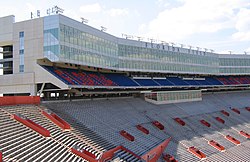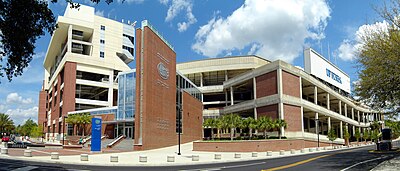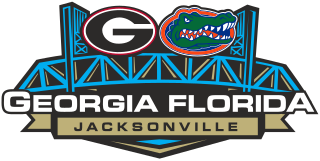
The Florida–Georgia football rivalry is an American college football rivalry game played annually by the University of Florida Gators and the University of Georgia Bulldogs, both members of the Eastern Division of the Southeastern Conference. The programs first met in 1904 or 1915 and have played every season since 1926 except for a war-time interruption in 1943. It is one of the most prominent rivalry games in college football, and it has been held in Jacksonville, Florida since 1933, with only two exceptions, making it one of the few remaining neutral-site rivalries in college football. The game attracts huge crowds to Jacksonville, and the associated tailgating and other events earned it the nickname of the "World's Largest Outdoor Cocktail Party", although that name is no longer officially used.
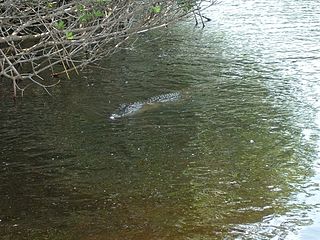
The Florida Gators are the intercollegiate athletic teams that represent the University of Florida, located in Gainesville. The University of Florida, its athletic program, its alumni and its sports fans are often collectively referred to as the "Gator Nation." The Gators compete in the National Collegiate Athletic Association (NCAA) and the Southeastern Conference (SEC) and are consistently ranked among the top college sports programs in the United States. The University of Florida currently fields teams in nine men's sports and twelve women's sports.

Stephen Orr Spurrier is an American former football player and coach. He played ten seasons in the National Football League (NFL) before coaching for 38 years, primarily in college. He is often referred to by his nickname, "the Head Ball Coach". He played college football as a quarterback for the Florida Gators, where he won the 1966 Heisman Trophy. The San Francisco 49ers selected him in the first round of the 1967 NFL draft, and he spent a decade playing in the National Football League (NFL), mainly as a backup quarterback and punter. Spurrier was inducted into the College Football Hall of Fame as a player in 1986.

Cajun Field is a football stadium located on the South Campus of the University of Louisiana at Lafayette in the city of Lafayette, Louisiana. Nicknamed The Swamp, it is the home field of Louisiana Ragin' Cajuns athletics. Cajun Field is primarily used for its American football team. Cajun Field has an official capacity of 41,426 with 2,577 chairback seats.

The Exactech Arena at the Stephen C. O'Connell Center, also known as the O'Dome, is a 10,500-seat multi-purpose arena located on the University of Florida campus in Gainesville, Florida. The facility is named for the sixth president of the university, Stephen C. O'Connell, who served from 1967 to 1973. The facility is located on the northern side of the university's campus, between its football field, Ben Hill Griffin Stadium at Florida Field, and the James W. "Bill" Heavener Complex athletic training center.

The Florida–Miami football rivalry is an American college football rivalry between the Florida Gators football team of the University of Florida and Miami Hurricanes football team of the University of Miami. The game was played annually from 1944 until 1987, and is now played intermittently. The winning team was formerly awarded the Seminole War Canoe Trophy. Today, the round robin winner of the three biggest schools in the state of Florida receives the Florida Cup for beating the other two schools in the same season. The two teams will next play in the 2024 and 2025 seasons. Miami leads the series 29–27.
Alfred A. McKethan Stadium at Perry Field was the college baseball stadium of the University of Florida, serving as the home field for the Florida Gators baseball team until being replaced by Condron Ballpark in 2020. McKethan Stadium was located on the university's Gainesville, Florida campus, in close proximity to the university's indoor sports arena, the Stephen C. O'Connell Center, and its football stadium, Ben Hill Griffin Stadium.

The Florida Gators football program represents the University of Florida (UF) in American college football. Florida competes in the Football Bowl Subdivision (FBS) of the National Collegiate Athletic Association (NCAA) and the Eastern Division of the Southeastern Conference (SEC) They play their home games on Steve Spurrier-Florida Field at Ben Hill Griffin Stadium on the university's Gainesville campus.

The University of Florida Fightin' Gator Marching Band, also known as The Pride of the Sunshine, is the official marching band for the University of Florida. The current era of the band is also referred to as The Sound of the Gator Nation. They perform at every Florida Gators home football game at Ben Hill Griffin Stadium and also at various other events such as pep rallies, parades, and the annual Orange and Blue spring scrimmage game. A full band usually travels to two away games a year while at other games a small/medium-sized pep band will attend. Members of the Gator Band, as well as other University of Florida students, are encouraged to join other ensembles such as concert band, jazz band, basketball band, and volleyball band. The twirlers for the Gator Band are referred to as the Gatorettes and the color guard is called the Florida Visual Ensemble.

The Florida–Florida State football rivalry is an American college football rivalry between the teams of the two oldest public universities of the U.S. state of Florida: the University of Florida (UF) Gators and Florida State University (FSU) Seminoles. Both universities participate in a range of intercollegiate sports, and for the last several years, the Florida Department of Agriculture and Consumer Services has sponsored a "Sunshine Showdown" promotion that tallies the total number of wins for each school in head-to-head sports competition. However, the annual football game between the Gators and Seminoles has consistently been the most intense and notable competition between the in-state rivals.

The Florida–Tennessee football rivalry, also called the Third Saturday in September, is an American college football rivalry between the Florida Gators football team of the University of Florida and Tennessee Volunteers football team of the University of Tennessee, who first met on the football field in 1916. The Gators and Vols have competed in the same athletic conference since Florida joined the now-defunct Southern Intercollegiate Athletic Association in 1910, and the schools were founding members of the Southeastern Conference in 1932. Despite this long conference association, a true rivalry did not develop until the early 1990s due to the infrequency of earlier meetings; in the first seventy-six years (1916–91) of the series, the two teams met just twenty-one times. The Southeastern Conference (SEC) expanded to twelve universities and split into two divisions in 1992. Florida and Tennessee were placed in the SEC's East Division and have met on a home-and-home basis every season since. Their rivalry quickly blossomed in intensity and importance in the 1990s and early 2000s as both programs regularly fielded national championship contending teams under coaches Phil Fulmer of Tennessee and Steve Spurrier at Florida.

The 1996 Florida Gators football team represented the University of Florida in the sport of American football during the 1996 NCAA Division I-A football season. The 1996 season was the team's seventh under head coach Steve Spurrier. The Gators competed in the Southeastern Conference (SEC) and played their home games at Ben Hill Griffin Stadium on the university's Gainesville, Florida campus.
The 1964 Florida Gators football team represented the University of Florida during the 1964 NCAA University Division football season. The season was the fifth for Ray Graves as the head coach of the Florida Gators football team. Graves' 1964 Florida Gators posted an overall record of 7–3 and a 4–2 Southeastern Conference (SEC) record, tying for second among the eleven SEC teams.

The 2000 Florida Gators football team represented the University of Florida in the sport of American football during the 2000 NCAA Division I-A football season. The Gators competed in Division I-A of the National Collegiate Athletic Association (NCAA) and the Eastern Division of the Southeastern Conference (SEC), and played their home games at Ben Hill Griffin Stadium on the university's Gainesville, Florida campus. They were coached by Steve Spurrier, who led the Gators to their sixth SEC championship, a Sugar Bowl berth, and an overall win–loss record of 10–3 (.769). The season was the team's eleventh of twelve under Spurrier.
The 1990 Florida Gators football team represented the University of Florida during the 1990 NCAA Division I-A football season. The season marked the return of the Gators' Heisman Trophy-winning quarterback Steve Spurrier to his alma mater as the new head coach of the Florida Gators football team.

George E. Edmondson Jr. was an insurance salesman from Tampa, Florida who was known to the University of Florida community as "Mr. Two Bits". Edmondson was a fan of the Florida Gators football team, for which he led a traditional "Two Bits' cheer" at football games beginning in 1949. Though he began the practice in an unofficial capacity, it eventually became so popular among fans at Florida Field that he was invited to lead the cheer from midfield before games, which he did from the mid-1970s until 2008. Citing health concerns, he retired from the role after the 2008 season and died in 2019.

The 2009 Florida Gators football team represented the University of Florida in the sport of American football during the 2009 college football season. The Gators competed in the Football Bowl Subdivision (FBS) of the National Collegiate Athletic Association (NCAA) and the Eastern Division of the Southeastern Conference (SEC), and played their home games at Ben Hill Griffin Stadium on the university's Gainesville, Florida campus. They were led by fifth-year head coach Urban Meyer, who coached the Gators to a first-place finish in the SEC East, a 51–24 Sugar Bowl victory over the Cincinnati Bearcats, and an overall win–loss record of 13–1 (.929).
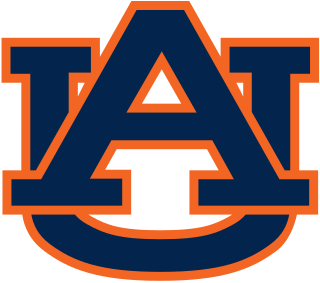
The Auburn–Florida football rivalry is an American college football rivalry between the Auburn Tigers football team of Auburn University and Florida Gators football team of the University of Florida which was first played in 1912. The schools have been members of the same athletic conference for over a century and were founding members of the Southeastern Conference (SEC) when it was established in 1933. The contest was an annual tradition from 1945 until 2002, when the SEC expanded and the rivalry became part of a rotation of other conference games. Since then, the teams have met only four times.
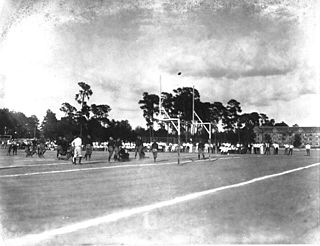
Fleming Field was the first on-campus home for the football and baseball teams representing the University of Florida in Gainesville. Construction began in 1910, and the facility debuted as the home field for Florida Gators outdoor sports programs during the spring semester of the 1910-1911 academic year.

The 2016 Florida Gators football team represented the University of Florida in the sport of American football during the 2016 NCAA Division I FBS football season. The Gators played their home games at Ben Hill Griffin Stadium in Gainesville, Florida, and competed in the Eastern Division of the Southeastern Conference (SEC). They were led by second-year head coach Jim McElwain. They finished the season 9–4, 6–2 in SEC regular season play to represent the Eastern Division in the SEC Championship Game where they lost to Alabama. They were invited to the Outback Bowl where they defeated Iowa.





